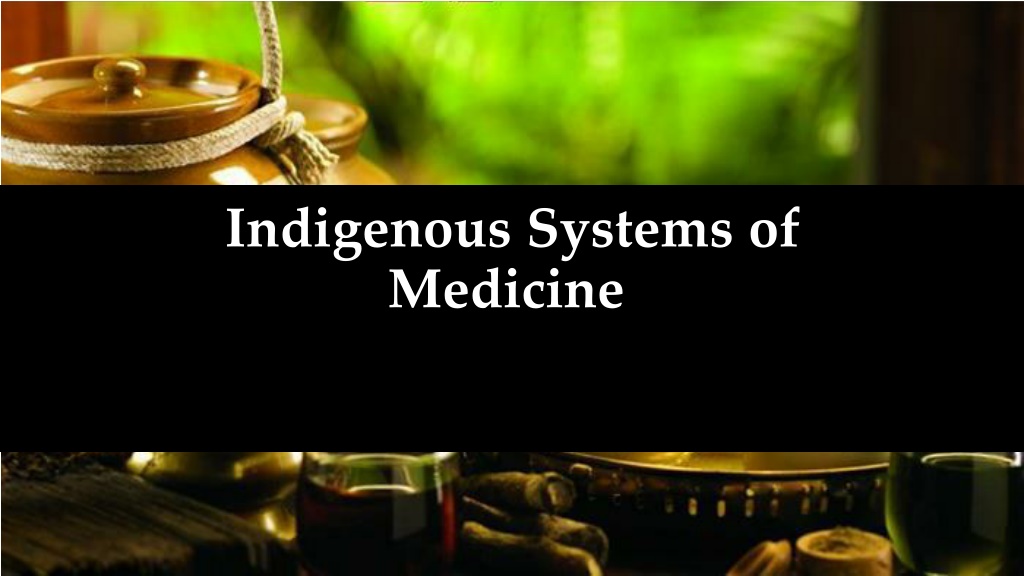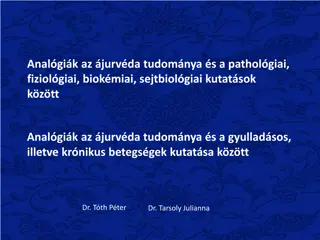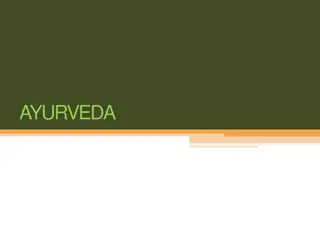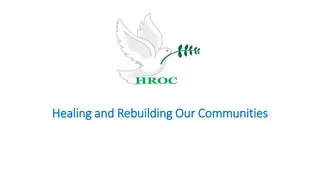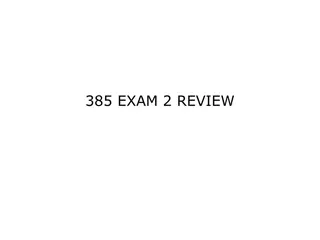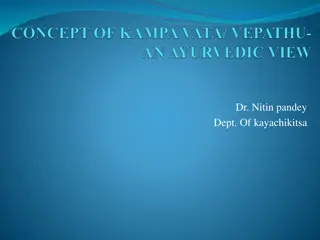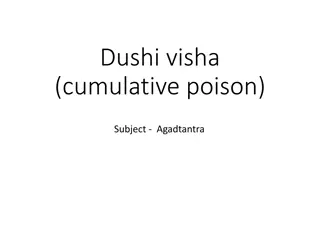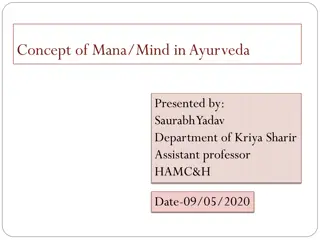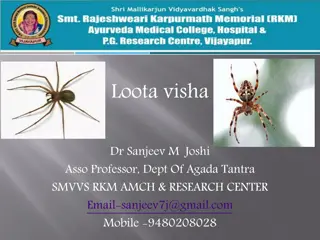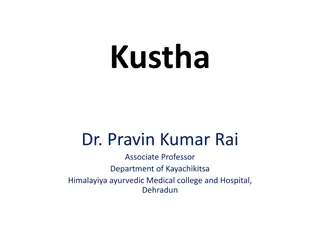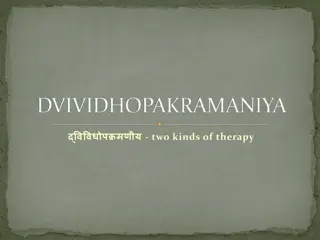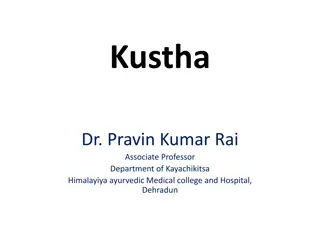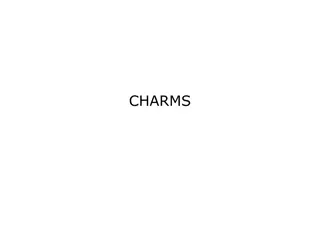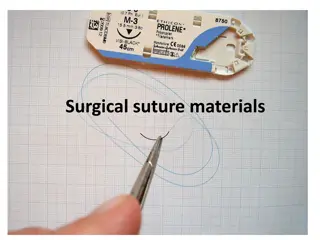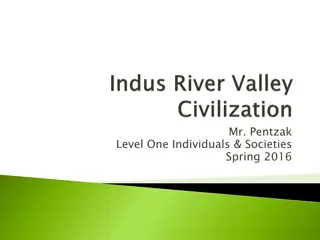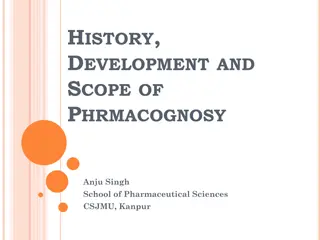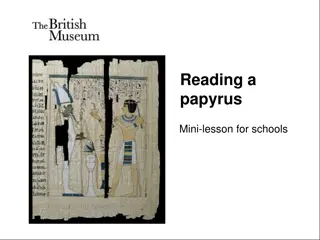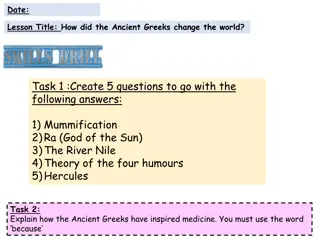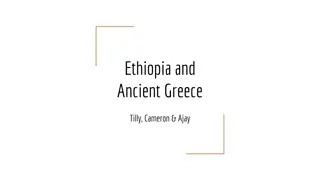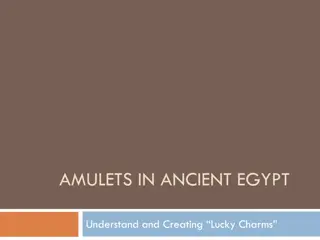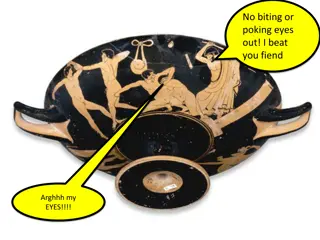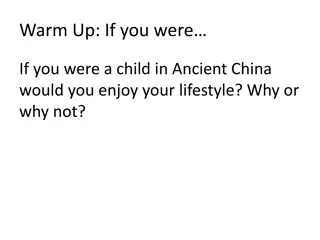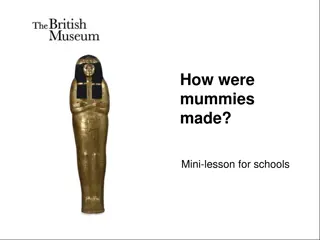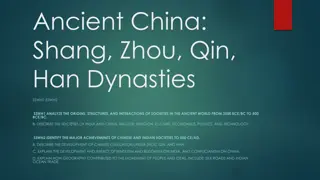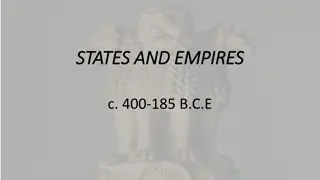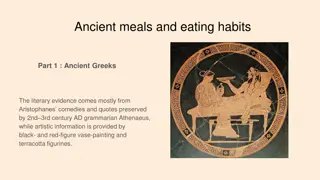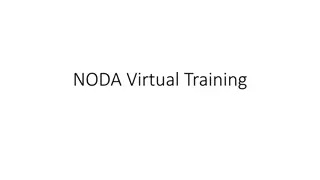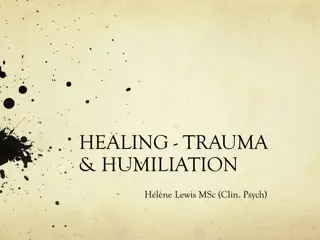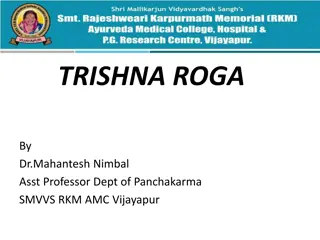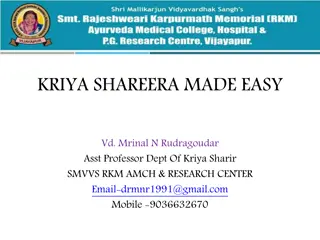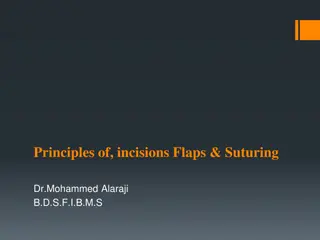Understanding Ayurveda: Ancient Healing System Explained
Ayurveda, a holistic healing system originating in India over 5,000 years ago, is based on the concept of five elements and three doshas. It encompasses the principles of Tri Gunas, Pancha Mahabhutas, and Sapta Dhatus among others. Ayurveda emphasizes the balance of mind, body, and spirit and utilizes natural remedies derived from plants and herbs. Diagnosis is done through traditional clinical examinations focusing on doshas and physical signs. Explore the rich history and basic principles of Ayurveda in this insightful overview.
Download Presentation

Please find below an Image/Link to download the presentation.
The content on the website is provided AS IS for your information and personal use only. It may not be sold, licensed, or shared on other websites without obtaining consent from the author. Download presentation by click this link. If you encounter any issues during the download, it is possible that the publisher has removed the file from their server.
E N D
Presentation Transcript
Indigenous Systems of Medicine
Introduction : An indigenous system is a natural form of medicine outside the stream of Western or Allopathic medicine practiced by majority of doctors all over the world today. These systems are Ayurveda , Siddha , Unani , Yoga , Naturopathy, Sowa - Rigpa .
Ayurveda : Ayurveda or ayurvedic medicine is one of the world's oldest holistic healing system. The term "Ayurveda" is derived from two Sanskrit words , Ayur and Veda . 'Ayur' means life & 'Veda' means Knowledge or science . Originated in India more than 5,000 years ago & is known as "Mother of All Healing". Originates from ancient Vedic Culture & was taught for many thousands of years.
History : The sacred 'Rigveda' describes 67 medicinal plants. 'Yajur Veda' mentions 81 species , 'Atharvaveda' describes 290 species & 114 hymns related to formulations for the treatment of different diseases from 4500 - 2500 BC . The first recorded treatise on Ayurveda during 700 BC describes properties & uses of 1,106 plants . 'Sushruta Samhita' during 800 BC explained different characteristics of fundamental principles & theory of surgery & description of about 1,270 plants & 650 drugs .
Basic Principles of Ayurveda : The principle of Ayurveda is based on the concept of 'Five Elements & Tridoshas '. According to Ayurveda , the whole universe made up of five basic elements are Akash (ether) , Vayu (air) , Agni (fire) ,Jal (water) , Prithvi (earth). 'Pancha Bhutas' are represented in human body as the Doshas , Dhatus & Malas . Three doshas in the body are Vata , Pitta & Kapha & are known as Tridoshas . 1) The Tri Gunas : 3 fundamental universal energies are Satva , Rajas & Tanas . 2) The Pancha Mahabhutas : 5 basic elements are Akasha , Vayu , Agni , Jala & Prithvi . 3) The TriDoshas : 3 Body Humours are Vata , Pitta & Kapha . Cont...
4)The Sapta Dhatus : 7 types of body tissues are Rasa Dhatu , Mamsa Dhatu , Meda Dhatu , Ashti Dhatu , Majja Dhatu , Sukra Dhattu . 5)The Trayodosa Agni : 3 types of digestive fires are Purisa (faeces) , Mutra (urine) & Sveda (sweat).
Diagnosis : Disease is a reaction between doshas & dhatus & is also influenced by the environment. The traditional clinical examination in Ayurveda ,known as Ashta Sthana Pariksha , includes an assesment of state of the doshas as well as various physical signs . The 8 point diagnosis are Shabda Pariksha , Jilwa Pariksha , Mala Pariksha , Kapha or Akriti , Pitta or Drik , Vata or Sparsha , Mutra Pariksha , Nadi Pariksha . Therapy often begins with shodhana (cleansing) in which toxins are eliminated . Once shodhana is completed , shaman(palliative) used to reduce the intensity of a disease & balance the disordered doshas. Finally,rasayana (rejuvention therapy) used to maintain health & reduce the negative effects of diseases.
Siddha : -Siddha is one of the oldest & most basic traditional systems of medicine. -Practiced in the state of Tamil Nadu. -It is an ancient science , which belongs to Dravidian Culture. -Siddha system insists the scientific mode of life . Its preliminary aim is prevention & preservation of health .
Principles : It also classifies physiological components of human beings as Vatha , Pitha & Kapha , like ayurveda. These medicines recognise predominance of vatham , pritham & kapam. Different physiological & psycological functions of the body occur due to the combination of 7 elements: First is Saram(plasma) responsible for growth,development & nourishment 2 is Cheneer(blood) responsible for nourishing muscles ,imparting colour 3 is Ooun(muscle) responsible for shape of the body - Fourth is Kollzuppu (fatty tissue)responsible for oil balance & lubricating joints Fifth is Enbu(bone) responsible for body structure & posture Sixth is Moolai(nerve) responsible for strength 7 is Sukila(semen) responsible for reproduction.
Diagnosis : Examination of 8 items commonly as astasthana-pariksa is required in diagnosis. 1) Na(tongue)-Tongue will be yellow in pitha, white in kapha &black in vatha. 2)Varna(colour)-Colour will be dark in vatha, yellow or red in pitha & pale in kapha. 3)Svara(voice)-Voice will be normal in vatha , highly pitched in pitha , low pitched in kapha& slurred in alcoholism. 4)Kan(eyes)-Eyes will be muddy conjunctive , yellowish or red in pitha & pale in kapha. 5)Sparisam(touch)-Touch will be dry in vatha , warm in pitha , chill in kapha & sweating in different parts of the body. 6)Mala(stool)-Black stools indicate vatha ,yellow pitha, pale in kapha ,dark red in ulcer & shiny in terminal illness. 7)Neer(urine)-Early morning urine is examined ; straw colour indicates indigestion , reddish yellow excessive heat, rose in blood pressure, saffron colour in jaundice & looks like meat washed water in renal disease. 8)Nadi(Pulse)-Confimatory method recorded on the radial artery.
Unani : Also called as 'Unani tibb ,Arabian medicine or Islamic medicine'. Origins of Unani Medicine are found in the doctorines of the ancient Greek physicians Hippocrates & Galen.
Origin: Unani system originated in Greece. The teachings of Greek physicians Hippocrates & Galen form the basis of theoretical framework of Unani medicine. Unani name is derived from the word 'Ionian' .
Principles: Based on Humoral Theory. There are four humours in body : 1) Dam(Blood) : A coagulated portion forms a red mass. 2)Balghem(Phlegm) : The whitish egg yolk like matter. 3)Safra(Bile) :The yellowish froth on upper surface . 4)Sauda(Black Bile) : The blackish sediments at the bottom . Concept of Tabiyat : 1) Ultimate power of the body. 2)It tunes the body to stay in a healthy condition. 3)Power of influence to repair & come out of disease condition. Continued....
In Unani Medicine , there are 6 factors , essential for maintenance of good health called 'Asbab-e-Sittah Zaruriah'- 3)Harkat-wa-Sukoon-e-Badania(Body movement& Repose) 1) Hawa-e-Muheet(Fresh Air) 2)Makool-o-Mashroob(Food&Drink) 4)Harkat-wa-Sukoon-e-Nafsania(Mental movement) 6)Ehibas-o- 5)Naum-o-Yaqzah(Sleep &Wakefulness) Istafraagh(Retention&Evacuation)
-In Unani system , human body is based on 7 natural principles known as UmureTabiya which is existence of human body. -Loss of anyone components could lead to deadth - 1)Element(Arkan) 2)Temperament(Mizaj) 3)Humours(Akhlat) 4)Organs(Aza) 5)Pneuma or Vital Spirit(Arwah) 6)Faculties of Power(Quwa) 7)Function(Al-Afal) -Every individual has an inherent power of self-preservation called the Quwwat-e-Modabbira .
Diagnosis : -Examination of Pulse(Nabz) -Examination of Urine(Baul) -Examination of Stool(Baraz) -Drugs made from medicinal plants,herbs,minerals,metallic & animal origin are used for the treatment of diseases.
-Modes of treatment : -Treatment is divided into four parts : 1)Ilaj-Bil-Ghiza(Dietotherapy)-Treatment through diet. 2)Ilaj-Bil-Tadbeer(Regimental Therapy)-Treatment through certain procedures , tools & equipments. 3)Ilaj-Bil-Dawa(Pharmacotherapy)-Treatment through drugs/medicines , which are of Plant, Mineral or Animal Origin. 4)Ilaj-Bil-Yad(Surgery)-Treatment through Minor/Major Operative Procedures.
